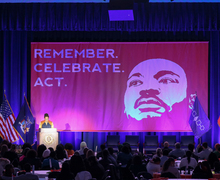Indigenous nation in western New York works to combat opioid epidemic
Casey Russell | Head Illustrator
Opioid overdoses among Native Americans has increased almost fourfold between 1993 and 2013.
There is no racial, ethnic or socioeconomic group that has remained unscathed in the opioid epidemic, but the Native American population has been especially hard-hit.
According to a 2014 study by the Substance Abuse and Mental Health Services Administration, Native American or indigenous people accounted for 0.9 percent of New York state substance abuse treatment admissions for prescription painkillers and around 0.5 percent for heroin, despite making up 0.4 percent of the state’s population.
“I suspect that the problem is hitting us a lot harder,” said Dawn Colburn, acting director of Seneca Strong, a substance abuse outreach and support program for members of the Seneca Nation of Indians in western New York. “(Two years ago,) we had five funerals in one week. … I’d never seen our community hit like that. Five funerals in one week.”
The opioid epidemic has claimed the lives of 2,185 New York residents in 2015 alone.
In 2014, Native Americans nationwide experienced the highest death rate from prescription opioid overdoses out of any racial or ethnic group, and the second-highest death rate from heroin overdoses — behind only non-Hispanic whites — according to PBS Frontline.
Between 1999 and 2013, the death rate from opioid overdose among Native Americans increased almost fourfold, according to the Indian Health Service, which administers federal health care to indigenous populations in the U.S.
Some experts believe one of the factors behind relatively high rates of substance abuse among Native Americans is intergenerational or historical trauma.
Historical trauma is defined as “cumulative emotional and psychological wounding over the lifespan and across generations, emanating from massive group trauma experiences,” according to a study by Maria Yellow Horse Brave Heart, a research associate professor in the University of New Mexico School of Medicine.
“When you look back to the boarding schools, and the removal and relocation era, we lost so much of our culture, we lost so much of our beliefs and identity and the cultural ways that we used to heal ourselves,” Colburn said.
“I think (opioids are) just an easy out when you’re dealing with that much pain and trauma,” she added.
Anthony Dekker, a pain management and addiction specialist who has worked for the IHS, said another reason for the higher rates of opioid addiction among Native people may be because they are more likely than other groups to need pain medicine.
“Many (Native Americans) … work in occupations that are higher-risk for injuries, so musculoskeletal injuries are more common in the American Indian population,” said Dekker, who noted he is not Native American, nor a spokesperson for any Native American nation.
Native American communities and organizations across the country have been taking steps to combat opioid addiction.
The White Earth Nation in Minnesota trained more than 100 tribal employees to treat overdoses, which saved at least 16 lives between October 2015 and October 2016.
The Cook Inlet Tribal Council in Alaska runs one of only two substance abuse treatment facilities in the state, serving 850 people each year.
The Indian Health Council in California set up a pill take-back program to help people get rid of excess prescription painkillers, according to the National Congress of American Indians’ Policy Research Center.
In New York, the Seneca Strong program aims to help rehabilitate people with drug addictions by reaching out to them through peers, fellow Seneca Nation members who have experienced addiction and are in recovery, Colburn said.
“I think the peer model is amazing,” Colburn said. “It removes the power differential between a therapist and a client … There’s no, ‘I’m better than you, or I have this degree, or that degree.’ It’s more, ‘I’ve lived the same thing that you’re living, I have life experience that I’m willing to share with you,’ and it takes all the judgement out.”
Colburn said Seneca Strong has reached out to 300 people in the Seneca Nation territories in the past year. Of those people, 109 entered in-patient treatment.
Seneca Strong also offers ongoing support for people who have left inpatient treatment. Physical activities, 12-step programs and cultural healing methods such as sweat lodges and talking circles are offered for people in recovery.
“I think the more we add the culture into (the recovery process), the better we do,” Colburn said.
The Seneca Nation has neither its own inpatient facility for addiction treatment nor adequate recovery housing for people who are returning from detox programs, Colburn said, largely due to limited funding.
She said this can be a challenge for some Seneca Nation members who do not feel comfortable leaving the Nation’s territories to seek treatment elsewhere.
Colburn and her colleagues have applied for several grants to establish new facilities, such as a drug court that would allow Seneca Strong to connect people who come to them through law enforcement with recovery services.
Furthermore, the Nation itself has a building that could be renovated to make space for recovery housing on the Nation’s territory.
“Down the road further, the tribe has looked at having our own inpatient rehab facility on territory where we can integrate more of the cultural stuff,” Colburn said. “That would be awesome.”
Published on September 5, 2017 at 11:52 pm
Contact Madeleine: mdavison@syr.edu





